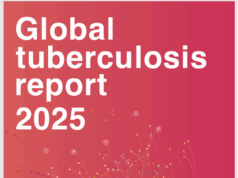NEW YORK, NY –GNUSA
Tuberculosis (TB) remains one of the world’s deadliest infectious diseases, claiming more than 1.2 million lives and affecting an estimated 10.7 million people in the past year, according to the WHO Global Tuberculosis Report 2025, released on November 12.
While there has been measurable progress in diagnosis, treatment, and innovation, persistent challenges—particularly in funding and equitable access to care—continue to threaten the momentum in the global fight against TB.
“Declines in the global burden of TB, and progress in testing, treatment, social protection and research are all welcome news after years of setbacks, but progress is not victory,” said Dr Tedros Adhanom Ghebreyesus, WHO Director-General. “The fact that TB continues to claim over a million lives each year, despite being preventable and curable, is simply unconscionable. WHO is working with countries to build on the progress they have made and accelerate the path to ending TB by 2030”.
Between 2023 and 2024, the global rate of new TB cases dropped by nearly 2%, and deaths declined by 3%—a modest but meaningful recovery of essential health services disrupted by the pandemic. Some regions stood out: the WHO African Region achieved a 28% reduction in TB incidence and a 46% drop in deaths since 2015. The European Region fared even better, with a 39% decrease in incidence and a 49% reduction in mortality.
Over 100 countries have now reached the first milestones of the WHO End TB Strategy, with at least a 20% reduction in new cases and 65 countries reporting 35% or more reductions in TB-related deaths.
In 2024, a staggering 87% of TB cases were concentrated in just 30 countries. Just eight of them accounted for 67% of the global total: India (25%), Indonesia (10%), the Philippines (6.8%), China (6.5%), Pakistan (6.3%), Nigeria (4.8%), the Democratic Republic of the Congo (3.9%) and Bangladesh (3.6%).
According to WHO, timely treatment for TB has saved an estimated 83 million lives since 2000. In 2024 alone, 8.3 million people accessed treatment—about 78% of those who fell ill. Rapid diagnostic testing expanded, treatment success rates for drug-susceptible TB held steady at 88%, and outcomes for drug-resistant TB improved, with 164,000 people receiving care and a 71% success rate, up from 68% the year before.
For the first time, WHO has reported on progress toward the social protection target established at the second UN High-Level Meeting on TB in 2023, using data compiled by the International Labour Organization (ILO). Among the 30 high TB burden countries, social protection coverage remains highly unequal, ranging from 3.1% in Uganda to 94% in Mongolia. Notably, 19 countries report coverage rates below 50%.
The report highlights that despite notable progress the world remains significantly behind in achieving the targets set by the End TB Strategy. Investment in TB research and development also falls short.
“We are at a defining moment in the fight against TB,” said Dr. Tereza Kasaeva, Director of the WHO Department for HIV, TB, Hepatitis and STIs. “Funding cuts and persistent drivers of the epidemic threaten to undo hard-won gains, but with political commitment, sustained investment, and global solidarity, we can turn the tide and end this ancient killer once and for all”.






